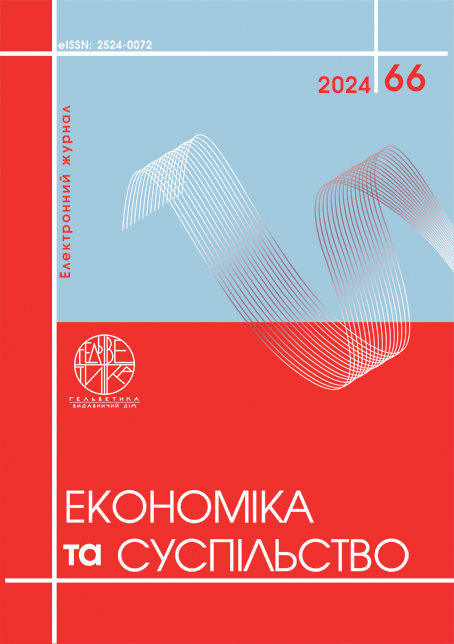ASSESSING THE FLEXIBILITY OF BUSINESS PROCESSES OF A FASHION INDUSTRY ENTERPRISE AS A COMPONENT OF THEIR QUALITY DURING MARTIAL LAW
Abstract
The article is devoted to the development of theoretical and methodological issues of assessing flexibility in fashion industry enterprises as a component of their quality. Modern business places special emphasis on the importance of purpose, vision and flexible strategies for enterprises if they are to create value for consumers and ensure their own sustainable development. Modern enterprises must be flexible in the face of emerging threats. The flexibility of a fashion industry enterprise is ensured by the flexibility of its business processes. Business process flexibility indicators characterize the quality of their implementation. The following types of business process flexibility are among the most important in fashion industry enterprises: marketing, technological, financial, information and digital, and environmental flexibility. To effectively manage the enterprise and the quality of its business processes, it is necessary to assess the achieved level of business process flexibility. At fashion industry enterprises, it is advisable to use the method of assessing the flexibility of business processes based on single, group and integral indicators. In the process of evaluation, in order to bring indicators with different units of measurement to a single scale, all dimensional indicators of business process flexibility are converted into dimensionless indicators (desirability functions) based on E. Harrington's desirability scale. The first step is to determine the strategic goals of the enterprise. At the second stage, the company's business processes are identified and the key ones are selected. At the third stage, the indicators characterizing the level of flexibility of the enterprise's business processes are determined. At the fourth stage of the observation, a list of indicators is determined that are indicators of the flexibility of the enterprise's business processes. At the fifth stage, the indicators are normalized. At the sixth stage, group indicators of the flexibility of a particular business process are determined. At the seventh stage, the integral indicator is calculated. At the eighth stage, the results of the assessment of the flexibility of the enterprise's business processes are analyzed.
References
Бондаренко С.М. Рейтингове управління конкурентоспроможністю продукції промислових підприємств (на прикладі взуттєвого виробництва) : автореф. дис. на здоб. наук. ступ. к. е. н: 08.06.01 – економіка підприємства й організація виробництва. Київ : Національний університет харчових технологій, 2002. 20 с.
Бондаренко С.М., Свиринюк О.В. Аналіз сучасних стратегій конкуренції. Збірник наукових праць. Київ : КНУТД, 2014. C. 56–62. URL: https://en.knutd.edu.ua/publications/pdf/Ukrainian_editions/Bondarenko2015060407.pdf
Демків І.О. Методичні підходи до оцінювання гнучкості підприємства в умовах нестабільного ринкового середовища. Економічний аналіз. 2015. Том 21. № 2. С. 55–62.
ДСТУ ISO 9000:2015 Системи управління якістю. Основні положення та словник термінів. (ISO 9000:2015 IDT). Київ : ДП «УкрНДНЦ», 2016. 45 с.
Касич А.О. Розвиток інвестиційно-інноваційних процесів в Україні: джерела, оцінка, перспективи. Кременчук : ТОВ «Кременчуцька міська друкарня, 2008. 334 с.
Музиченко М.В. Використання логістичної функції Ферхюльста як функції бажаності для нормування показників безпеки постачання природнього газу. Економіка і суспільство. 2017. Випуск 9. С. 83–88.
Федулова І.В. Підходи до оцінки рівня готовності підприємства щодо інноваційного розвитку. Вісник Київського національного університету імені Тараса Шевченка. Економіка. 2011. Випуск 124-125. С. 36–40.
Халімон Т.М. Гнучкість в системі управління конкурентоспроможністю підприємства. Економіка. Менеджмент. Бізнес. 2018. № 1 (23). С. 74–80.
Шатілова О.В. Стратегічна гнучкість підприємства: сутність категорії та підходи до класифікації. Економіка підприємства: теорія та практика: збірник матеріалів ІV Міжнародної науково-практичної конференції (м. Київ, 12 жовтня 2012 р.). Київ : КНЕУ, 2012. С. 219–222.
Шуляр Р.В. Механізми гнучкості та адаптивності систем управління якістю бізнес-процесів підприємств. Проблеми системного підходу в економіці. 2018. Випуск 5. С. 145–150.
Bondarenko S.M. (2002) Reitynhove upravlinnia konkurentospromozhnistiu produktsii promyslovykh pidpryiemstv (na prykladi vzuttievoho vyrobnytstva) [Rating management of the competitiveness of products of industrial enterprises (on the example of footwear production)] (PhD Thesis), Kyiv: Kyivskyi natsionalnyi universytet tekhnolohii ta dyzainu, 20 p. (in Ukrainian)
Bondarenko S.M., Svyryniuk O.V. (2014) Analis suchasnykh stratehii konkurentsii [Analysis of modern competition strategies]. Zbirnyk naukovykh prats [Collection of scientific works]. Kyiv: KNUTD, pp. 56–62. URL: https://en.knutd.edu.ua/publications/pdf/Ukrainian_editions/Bondarenko2015060407.pdf (in Ukrainian)
Demkiv I.O. (2015) Metodychni pidkhody do otsiniuvannia hnuchkosti pidpryiemstva v umovakh nestabilnoho rynkovoho seredovyshcha. [Methodological approaches to assessing enterprise flexibility in an unstable market environment]. Ekonomichnyi analiz, Tom 21. Vol. 2, pp. 55–62.
UkrNDNTs (2016) DSTU ISO 9000:2015 Systemy upravlinnia iakistiu. Osnovni polozhennia ta slovnyk terminiv [Quality management systems. Basic provisions and glossary of terms]. Kyiv: UkrNDNTs, 45 p. (in Ukrainian)
Kasych A.O. (2008) Rozvytok investytsiino-innovatsiinykh protsesiv v Ukraini: dzherela, otsinka, perspektyvy [Development of Investment and Innovation Processes in Ukraine: Sources, Assessment, and Prospects]. Kremenchuk: TOV «Kremenchutska miska drukarnia», 334 p. (in Ukrainian)
Muzychenko M.V. (2017) Vykorystannia lohistychnoi funktsii Ferkhiulsta yak funktsii bazhanosti dlia normuvannia pokaznykiv bezpeky postachannia pryrodnoho hazu [Using the Ferhulst Logistic Function as a Desirability Function for Normalizing the Security of Natural Gas Supply]. Ekonomika i suspilstvo, Vol. 9, pp. 83–88.
Fedulova I.V. (2011) Pidkhody do otsinky rivnia hotovnosti pidpryiemstva shchodo innovatsiinoho rozvytku [Approaches to assessing the level of enterprise readiness for innovative development]. Visnyk Kyivskoho natsionalnoho universytetu imeni Tarasa Shevchenka. Ekonomika, vol. 124–125, pp. 36–40.
Khalimon T.M. (2018) Hnuchkist v systemi upravlinnia konkurentospromozhnistiu pidpryiemstva [Flexibility in the enterprise competitiveness management system]. Ekonomika. Menedzhment. Biznes, vol. 1 (23), pp. 74–80.
Shatilova O.V. (2012) Stratehichna hnuchkist pidpryiemstva: sutnist katehorii ta pidkhody do klasyfikatsii [Strategic flexibility of an enterprise: the essence of the category and approaches to classification]. Ekonomika pidpryiemstva: teoriia ta praktyka: zbirnyk materialiv IV Mizhnarodnoi naukovo-praktychnoi konferentsii (Kyiv, October 12, 2012). Kyiv: KNEU, pp. 219–222.
Shuliar R.V. (2018) Mekhanizmy hnuchkosti ta adaptyvnosti system upravlinnia yakistiu biznes-protsesiv pidpryiemstv [Mechanisms of flexibility and adaptability of quality management systems of business processes of enterprises]. Problemy systemnoho pidkhodu v ekonomitsi, vol. 5, pp. 145–150.

This work is licensed under a Creative Commons Attribution 4.0 International License.


